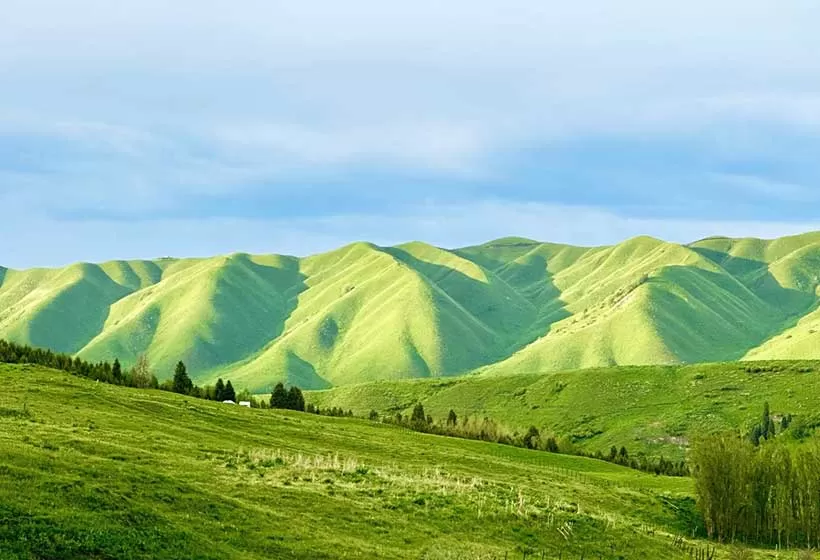Top Attractions and best sightseeings in Xinjiang
When talking about the magnificent places in China, Xinjiang undoubtedly stands out as a shining jewel. Located in the northwest frontier of China, Xinjiang is renowned for its vast lands, rich ethnic culture, and stunning natural landscapes. Following is the Xinjiang top 10 attractions, which may help you to appreciate the breathtaking scenery of this magical land.
Top 1: Tianchi Lake
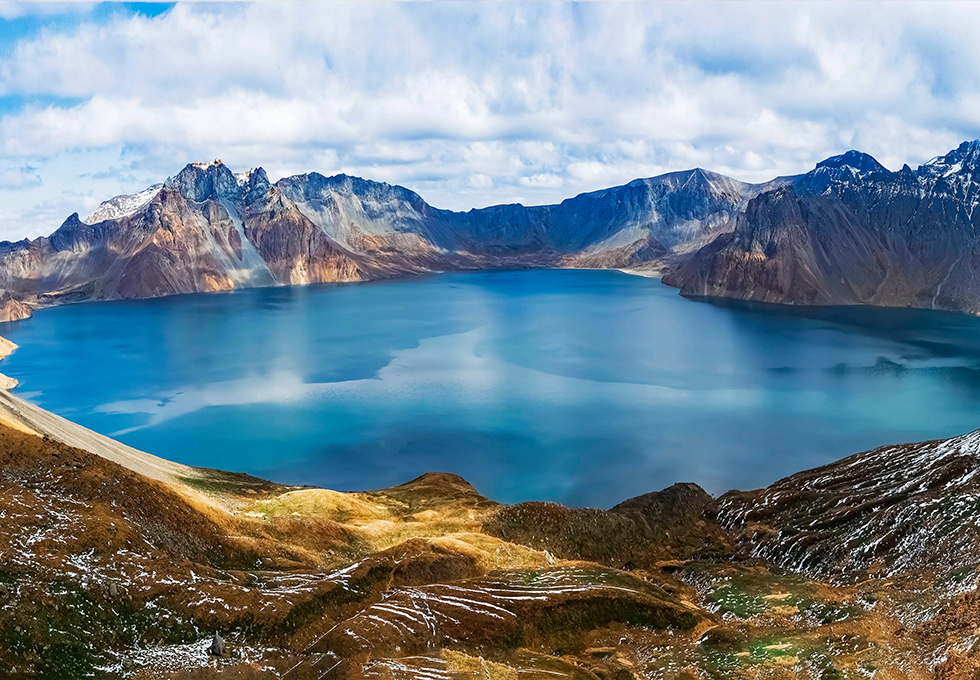 Tianchi Lake
Tianchi LakeTianchi Lake of Tianshan, meaning heavenly lake, located about 110 kilometers northeast of Urumqi in Xinjiang, is one of the most famous tourist attractions in the region, often referred to as the "Pearl of Tianshan". This alpine moraine lake, formed over two million years ago during the Quaternary Glacier Period, sits at an altitude of 1910 meters and reaches a depth of 105 meters. The lake reflects the snow-capped Bogda Peak, surrounded by dense spruce forests, creating a picturesque and almost otherworldly scenery.
Tianchi Lake is characterized by its vertical natural landscape zones, snow mountains, glaciers, and alpine lakes, imbued with the ancient myth of the Queen Mother of Yaochi, as well as unique ethnic customs, making it an ideal destination for sightseeing and cultural experiences. Visitors can enjoy boat rides on the lake to take in the stunning views or hike in the Tianshan to experience the grandeur of the alpine meadows.
- Address: No. 111 Provincial Road, Fukang City, Changji Hui Autonomous Prefecture, Xinjiang
- Open Hours: 10:00 AM – 07:00 PM
- Tour Length: 6-8 hours
Top 2: Kanas Lake
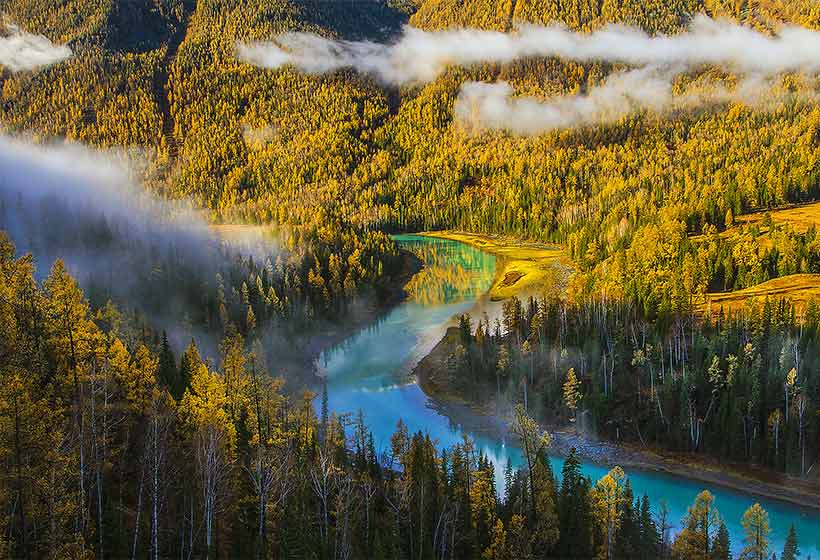 Kanas Lake
Kanas Lake"Kanas" is a Mongolian term meaning "beautiful and mysterious lake", renowned for its stunning natural scenery and enigmatic legends, often referred to as a "paradise on earth". Kanas Lake sits at an altitude of 1374 meters with a depth of 188.5 meters, making it the deepest moraine-dammed lake in China, that is an alpine and inland freshwater lake nestled within the dense forests of the Altai Mountains.
Kanas Lake is famous for its crystal-clear waters, which display deep blue and emerald green hues that change with the weather and light conditions. The lake is home to many rare aquatic creatures, such as otters and water snakes. Along the shore, there is a picturesque sandbank known as "Moon Bay", which adds to the lake's charm as it beautifully complements the surrounding water.
- Address: Northern of Burqin County, Altay Prefecture, Xinjiang
- Open Hours: 08:00 AM – 07:00 PM
- Tour Length: 4-6 hours
Top 3: Bayanbulak Grassland
Bayinbuluk Grassland is not only the second-largest grassland in China but also the largest alpine grassland in the country. Located 363 kilometers from Korla City in the northwest of Hejing County, Bayinbuluk means "abundant springs" in Mongolian, which is a typical grassland and the most fertile summer pasture on the southern slopes of the Tianshan.
The grassland is home to China's largest population of wild swans, in which the famous Bayinbuluk Swan Lake and the picturesque Eighteen Bends are popular destinations for photographers. The Bayinbuluk Grassland area is inhabited by nine ethnic groups, showcasing a vibrant and diverse cultural heritage. The annual Grassland Naadam Festival, featuring horse racing, archery, and other competitions, attracts visitors and leaves a lasting impression.
- Address: No. 217 National Highway, Hejing County, Bayingolin Mongol Autonomous Prefecture, Xinjiang
- Open Hours: 08:30 AM – 06:00 PM
- Tour Length: 0.5-1 day
Top 4: Pamirs Plateau
The Pamirs Tourist Area, located in Kashgar, Xinjiang, is a must-visit destination for travelers to the region. Known as the roof of Asia, the Pamirs Plateau features numerous towering peaks, including Muztagh Ata, K2, and Kongur Tagh. The terrain is complex and varied, with towering mountains and expansive alpine grasslands, creating a unique geographical landscape.
In addition to its natural beauty, the Pamirs Plateau is rich in historical significance as a key route on the ancient Silk Road. The area is home to numerous historical relics, such as the ancient beacon tower on the shores of Karakul Lake and the famous pearl of the Silk Road Kashgar Old City, which bear witness to millennia of historical change.
- Address: Tashkurgan Tajik Autonomous County, Kashgar Prefecture, Xinjiang
- Open Hours: 00:00 AM – 12:00 PM
- Tour Length: 2-3 days
Top 5: Taklamakan Desert
The Taklamakan Desert is China's largest desert and the world's second-largest drifting desert, known as the "Sea of Death". Covering an area of 330,000 square kilometers, it receives less than 100 mm of annual precipitation, while the average evaporation rate is as high as 2500 to 3400 mm. The fierce winds can raise sand walls up to three times their height. The desert is characterized by vast stretches of sand dunes that constantly shift due to the wind. Despite the extreme aridity, the desert is traversed by internal rivers like the Tarim River, which bring a touch of life to this barren landscape.
Traversing the Taklamakan Desert by following the desert highway is an unforgettable experience. Under the vast sky, the endless expanse of the desert imparts a profound sense of awe, making anyone who witnesses it feel the insignificance of human life. Along the way, you can often see the picturesque euphrates poplar standing quietly among the dunes, surviving in harmony with the harsh desert environment, evoking a deep sense of endurance and the cyclical nature of life and death.
- Address: Central Tarim Basin, Xinjiang.
- Open Hours: 00:00 AM – 12:00 PM
- Tour Length: 4-6 hours
Top 6: Flaming Mountains & Grape Valley
Flaming Mountains, located on the northern edge of the Turpan Basin along the northern route of the ancient Silk Road, run east to west. This area is one of the hottest places in China and one of the few extreme high-temperature zones in the world, historically known for a century-long burning. Although the mountains are not high, their entire surface is a deep red, with folds running through the peaks, resembling towering flames rising from the desert.
To the west of Flaming Mountains lies a valley known as Grape Valley, which resembles a green ribbon tightly wrapping around the reddish foothills of the Flaming Mountains. The valley stretches 7 kilometers in length and about 2 kilometers at its widest point. It is filled with vineyards, with the Buyluq River flowing through, creating a lush, tree-lined, and cool environment that contrasts sharply with the heat of Flaming Mountains.
- Address: No. 312 National Highway, Gaochang District, Turpan City, Xinjiang
- Open Hours: 09:30 AM – 07:30 PM
- Tour Length: 4-5 hours
Top 7: Ili River Valley
The Ili River Valley is one of Xinjiang's most renowned natural scenic areas, rich in ecological resources and unique natural landscapes. Known as the "Jiangnan beyond the Great Wall", it is one of the world's top three lavender growing regions. The Ili River Valley is home to the Ili River, the largest river in Xinjiang, Sayram Lake, the highest alpine lake in the region, the Nalati Grassland, known as the "Sky Grassland", and the Kalajun Grassland, one of China's most beautiful alpine natural grasslands. Here, you can experience the wonders and charm of nature and appreciate the rugged and bold beauty of China's northwestern frontier.
- Address: Kazak Autonomous Prefecture of Ili, Northwest corner of Xinjiang
- Open Hours: 00:00 AM – 12:00 PM
- Tour Length: 3-7 days
Top 8: Hemu Village
Hemu Village is one of Xinjiang's most famous ancient villages, known as "China's First Village", boasting a rich history and unique folk customs. Surrounded by mountains, Hemu Village is like an emerald gem set among the peaks. Visitors can explore various historical relics and folk exhibitions, such as the Hemu River, birch forests, and traditional wooden houses of the Tuva people. In this tranquil setting, tourists can temporarily escape the hustle and bustle of everyday life, immerse themselves in the fragrant atmosphere of nature, and appreciate the vibrant and magical beauty bestowed by the heavens.
- Address: Kom-Kanas Mongolian Ethnic Township, Burqin County, Altai Prefecture, Xinjiang
- Open Hours: 08:30 AM – 08:00 PM
- Tour Length: 1-2 days
Top 9: Kuqa Grand Canyon
The Kuqa Grand Canyon, one of Xinjiang's most famous natural scenic areas, is known in Uyghur as the "Red Cliff". With an elevation of over 2800 meters, the canyon runs east to west and was formed by meltwater from the Tianshan carving out a 50-meter deep, 5-kilometer-long fissure, dubbed the "Devil's Canyon" and "King of Canyons". The entire canyon is composed of massive red-brown mountain formations, creating a magnificent and undulating landscape, with peaks drenched in shades of red. Standing at the canyon floor and looking up, the steep cliffs seem poised to collapse at any moment, creating a sense of awe and vertigo. Visitors can also witness the rare and breathtaking sight of a narrow strip of sky, known as "One-Line Sky".
- Address: No. 217 National Highway, Ager Township, Kuqa City, Aksu Prefecture, Xinjiang
- Open Hours: 10:00 AM – 05:00 PM
- Tour Length: 2-3 hours
Top 10: Xinjiang International Grand Bazaar
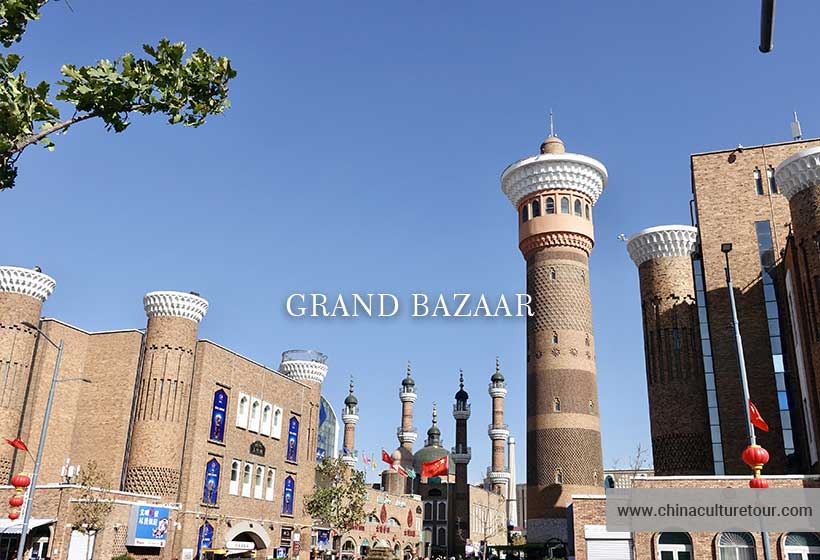 Grand Bazaar
Grand BazaarThe Xinjiang International Grand Bazaar is the world's largest bazaar, integrating Islamic culture, architecture, ethnic commerce, entertainment, and dining. It serves as a hub and showcase for Xinjiang's tourism products, earning the titles "Window of Xinjiang", "Window of Central Asia", and "Window of the World". The bazaar features rich Islamic architectural styles, combining functionality and modernity while recreating the prosperity of the ancient Silk Road. It epitomizes the vibrant ethnic characteristics and regional culture of the Western Regions.
- Address: No. 8 Jiefang South Road, Tianshan District, Urumqi City, Xinjiang
- Open Hours: 00:00 AM – 12:00 PM
- Tour Length: 1-3 hours
Customize Your Unique Xinjiang Silk Road Tour

If you are interested in one of the Xinjiang itineraries mentioned above, please contact us, and we will be happy to customize it and provide a quote tailored to your preferences.
Alternatively, if you would like to customize your Xinjiang Tour, please visit our Xinjiang Tour Customized Center. We assure you that you will receive a reply within 24 working hours.
Informative Articles for Your Xinjiang Trip
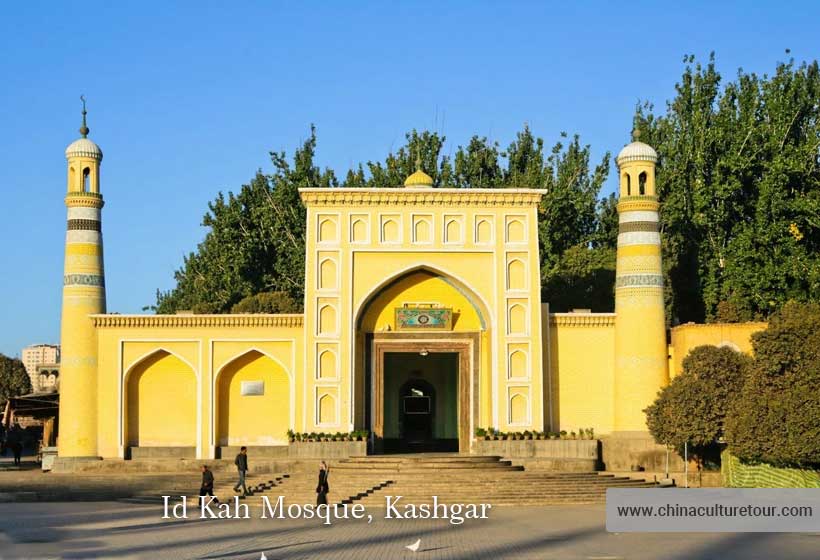 Id Kah Mosque, Kashgar
Id Kah Mosque, Kashgar- Travel Guide: attractions, seasons, hotels, food, itineraries, etc.
- Top destinations: places to visit in Xinjiang
- Travel itineraries: best itineraries for your reference
- Local culture: brief history, ethnic culture, religion, etc.
- Weather: the best time and seasons to visit Xinjiang
- Top attractions: things to do in Xinjiang
- Cultural immersions: hands-on activities to spotlight your trip
- Unique perspective: top different things to do
- Local food: what to eat while traveling in Xinjiang
- Luxury hotels: where to stay in Xinjiang
- Xinjiang Tours: tailor-made Xinjiang Tours for your reference
GREAT FAMILY CHINA TOUR
JULY 2024 We wanted to thank Grace at China Culture tour for organizing a great tour of China. We enjoyed our Beijing - Xian-Chengdu -Guilin -Yangshuo - Shanghai trip. Our local guides Bruce in Beijing, Susan in Xian, Jane in Chengdu, Mike in Guilin and Mary in Shanghai took care of us…read more details »
Teng Han L from SINGAPORE
Ready to Create a Unique Dream Travel?
